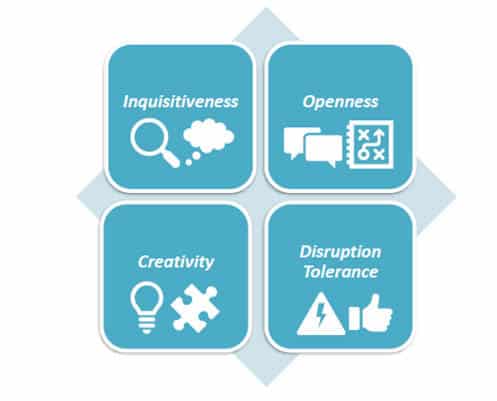Use Curiosity to Navigate Leadership Challenges

It is generally understood that your effectiveness and productivity as a leader are paramount to your organization’s success. A key factor supporting your effectiveness is curiosity. This article describes the attributes of curiosity, outlines four ways curiosity helps you navigate leadership challenges, and offers practical tips for leading with curiosity.
Introduction
Executives need to have a highly developed ability to help their organizations navigate challenges, and this ability is central to the firm’s success. Today’s business environment offers no shortage of challenges, thanks to shifting company boundaries, accelerating organizational and technological change, rapid globalization of customer and labor markets, and the increasing complexity of stakeholder networks. These conditions can make it ever more difficult to tease out the issues, identify root causes, and design effective solutions.
According to Francesco Gino, behavioral scientist and the Tandon Family Professor of Business Administration at Harvard Business School, curiosity helps leaders and their followers adapt to these volatile market conditions and external pressures by prompting them to think deeper, more rationally, and creatively.[1] The following sections describe what curiosity is, how it aids leaders in navigating challenges, and tips for leading with curiosity.
What is Curiosity
Curiosity is understood as recognizing, pursuing, and wanting to explore new, uncertain, complex, and ambiguous events.[2] A recent study by Merck KGaA[3] identified four components of curiosity:
- Inquisitiveness: seeking to understand what is really happening by examining new or complex situations. Key to inquisitiveness is taking on many alternate perspectives, helping us move beyond the status quo.
- Creativity: architecting novel solutions based on critical analysis of the current situation and cross-pollination of ideas from other parts of the organization or other industries.
- Openness: entertaining and deferring judgment of unconventional ideas. Remaining open helps us detect subtle cues others miss, which can lead to additional new ideas. Openness also is linked to adaptability and resisting conventional but ill-fitting solutions in favor of novel, effective solutions.
- Disruption tolerance: having the staying power to try out unconventional, even risky ideas that have the potential of being highly effective. Disruption tolerance is especially valuable in ambiguous situations, when we are at risk for choosing low-risk, non-creative solutions that may offer few, if any, benefits.
Figure: Four Central Attributes of Curiosity

Four Ways Curiosity Aids in Navigating Leadership Challenges
Leading with curiosity enhances executives’ ability to navigate challenges in four specific ways.
Effect 1: Makes challenges more achievable
When challenges seem threatening or stressful, we tend to perceive that the situation calls for knowledge, traits, abilities, or resources that exceed what we have available. The risk of failure seems to outweigh the chance for success or gain and, rather than rising to the challenge, we shrink from it and choose low-risk, potentially ineffective solutions. But when we embrace curiosity, our outlook about the situation, ourselves, and possible outcomes tend to be more positive. Curious people perceive challenges as ways to obtain valuable experience—no matter the outcome. This, in turn, strengthens their commitment to work through novel, complex, and uncertain situations and to be stimulated rather than stressed by that process. In turn, we are more likely to feel competent for the challenge, reframing the difficult goal as attainable.[4] With a curious mindset, we may even tend to enjoy tackling the challenging issue and find the effort stimulating.[5]
Effect 2: Encourages productive self-directed action
When we act from a place of curiosity, we tend to be driven by our interests and values and align these with the goals of our organization rather than be motivated by external rules, forces, or social pressures.[6] Kashdan and his colleagues5 found in their research that such self-directed or self-guided people recognize, pursue, and flourish when facing challenges. Self-guided leaders typically welcome, integrate, and learn from negative experiences as readily as they do from positive experiences. This in turns means we are less susceptible to fall back on non-adaptive self-preservation or survival behaviors that undermine our decision-making and effectiveness. This is one of the reasons why curious individuals tend to report better performance, greater well-being, and lower stress.[7]
Effect 3: Lowers defensiveness
Curiosity helps us remain open to our experiences and we are more likely to perceive challenges without distortion, feelings of threat, and the overwhelming urge to avoid failure.[8] In turn, we become more resilient and rely more on active, adaptive coping rather than defensive and avoidant responses. Active coping styles boost our self-perceptions such that we view ourselves and our chances for success more favorably.[9]
Effect 4: Activates mindfulness
Non-defensive openness to experiences also is associated with mindfulness, which is described as a non-evaluative, receptive, moment-to-moment attention or awareness.7 Organizational researchers Megan Reitz and Michael Chaskalson reported that, based on their 2016 study of 57 senior business leaders, mindfulness training improves critical 21st century leadership competencies, including resilience, ability to collaborate, and competence to lead in complex conditions.[10] More importantly, while these results required mindfulness practice of at least 10 minutes daily, it appears that regular exercise of curiosity may have similar effects.
Tips for Leading with Curiosity
The effects listed above are more likely the more you lead with curiosity. Below are four tips for doing just that:
- Keep a daily journal of how you used curiosity in ways that contributed to a beneficial leadership outcome. After two weeks, review your journal and identify any patterns in the data, insights about how you use curiosity, and what implications these have for your leadership.
- Facilitate a team meeting about a current business challenge or issue using the following questions:
- What are five ways to restate or reframe the issue?
- What are five potential solutions to the issue?
- What assumptions are you making? Which are based in current reality versus past experience(s)?
- What information do you still need and what resources could you use to get the information?
Defer your own judgments and refrain from answering the questions until all members have individually contributed.
- Consider a leadership situation in which someone has offended you or you felt excluded. Apply the four attributes of curiosity to consider how you could reframe the situation. How might your curiosity help you face a similar situation in the future?
- Encourage your direct reports to take the time to be more inquisitive, explore new, creative ideas, reframe threats into opportunities, challenge their preconceptions and the status quo (e.g., why is this done this way?), and present at least three solutions to any one issue.
[1] Gino, F. (2018, September-October). Why curiosity matters. Harvard Business Review. Available at https://hbr.org/2018/09/curiosity
[2] Kashdan, T., Stiksma, M., Disabato, D., McKnight, P., Bekier, J., Kaji, J., & Lazarus, R. (2017). The five-dimensional curiosity scale: Capturing the bandwidth of curiosity and identifying four unique subgroups of curious people. Journal of Personality, 73, 130–149.
[3] Merck KGaA-EMD Group (2016). Be curious: State of curiosity report 2016. https://www.emdgroup.com/content/dam/web/corporate/non-images/company/curiosity/Curiosity_Full-Report_English.pdf
[4] Blom, T. (2018). Organisational wellness: Human reaction to change, South African Journal of Business Management, 49(1), 1-10. https://doi.org/ 10.4102/sajbm.v49i1.2
[5] Kashdan T., Rose P., Fincham F. (2004) Curiosity and exploration: Facilitating positive subjective experiences and personal growth opportunities. Journal of Personality Assessment, 82:3, 291–305
[6] Deci, E.L., & Ryan, R.M. (2000). The ‘what’ and ‘why’ of goal pursuits: Human needs and the self-determination of behavior. Psychological Inquiry, 11, 227–268.
[7] Weinstein & Ryan, N., & Ryan, R. M. (2011). A self-determination theory approach to understanding stress incursion and response. Stress and Health, 27, 4–17. doi: 10.1002/smi.1368.
[8] Kashdan, T. B., Afram, A., Brown, K. W., Birnbeck, M., & Drvoshanov, M. (2011). Curiosity enhances the role of mindfulness in reducing defensive responses to existential threat. Personality and Individual Differences, 50, 1227-1232. doi:10.1016/j.paid.2011.02.015
[9 ] Weinstein, N., Przybylski, A. K., & Ryan, R. M. (2012). The index of autonomous functioning: Development of a scale of human autonomy. Journal of Research in Personality, 46, 397–413.
[10] Reitz, M., & Chaskalson, M. (2016, December 1). How to bring mindfulness to your company’s leadership. Available at https://hbr.org/2016/12/how-to-bring-mindfulness-to-your-companys-leadership
Bring the best of the CEOWORLD magazine's global journalism to audiences in the United States and around the world. - Add CEOWORLD magazine to your Google News feed.
Follow CEOWORLD magazine headlines on: Google News, LinkedIn, Twitter, and Facebook.
Copyright 2025 The CEOWORLD magazine. All rights reserved. This material (and any extract from it) must not be copied, redistributed or placed on any website, without CEOWORLD magazine' prior written consent. For media queries, please contact: info@ceoworld.biz








